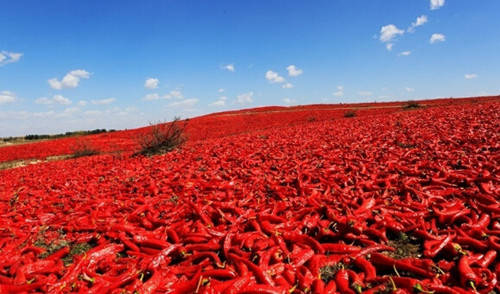Pakistan-China chili production collaboration is going to make a significant step as the first batch will be harvested by the end of November.
The first batch of 500 tons of Pakistani chilies is expected to be harvested by the end of November, marking a significant step in the Pakistan-China Center project within the Shanghai Cooperation Organization (SCO) Demonstration Zone.
Liu Jing, business manager of the China-Pakistan International Cooperation Hub, one of the project participants, stated, “These chilies will be distributed across China, including in provinces like Guizhou, Yunnan, Sichuan, Chongqing, Hunan, and Hubei.”
Liu outlined the project’s timeline: “Following this harvest season in Pakistan, we plan to start breeding and planting seedlings in February, with the next harvest set for May. Our goal is to build a comprehensive industrial chain that covers planting, harvesting, processing, and exporting, while also expanding research on chili seeds and enhancing mechanical production and deep processing.”
Pakistan’s Chili Production Advantage
Pakistan ranks as the world’s fourth-largest producer of chilies, thanks to its favorable climate and cost-effective production methods. Liu noted that China has played a crucial role in enhancing the quality of chilies by providing technical guidance on seeds, planting techniques, and the use of pesticides and fertilizers.
The project is currently spread over a planting area of 200,000 mu (about 13,340 hectares), with Chinese experts offering full technical support. In addition to traditional varieties such as SV7864, new, improved varieties from Shandong, Hainan, and Xinjiang have been introduced. High-spiciness chilies, with Scoville Heat Units (SHU) exceeding 120,000, have already been successfully cultivated in Pakistan.
Modern processing and storage facilities established by Chinese businesses in Pakistan have significantly increased the value of local agricultural products. A Pakistani supplier explained, “This collaboration has boosted both the quality and quantity of chili exports to China. Thanks to joint efforts, we’ve adopted modern agricultural practices, improved seed quality, and streamlined export procedures. This partnership is a replicable model that benefits Pakistani farmers, Chinese buyers, and bilateral trade.”
Plans are also underway to establish a 170-acre China-Pakistan Agricultural Cooperation Industrial Park. The park will focus on three primary areas: transactions, basic processing, and deep processing. While traditional processing includes chili powder and sauces, deep processing will involve extracting edible red pigments, capsaicin for biopharmaceuticals, and special coatings—injecting “pepper energy” into a variety of industries.
Sustainable and Innovative Growth
With Chinese guidance, Pakistan’s chili industry is gaining recognition in the market. Capsaicin, in particular, has proven to be a sustainable resource, with applications ranging from natural, pollution-free pesticides to pharmaceuticals.
“The advantages of Pakistan’s chilies are becoming increasingly apparent,” Liu highlighted. “This project exemplifies the potential for cross-border agricultural cooperation and demonstrates the growing synergy between our two nations.”
Related Posts

















